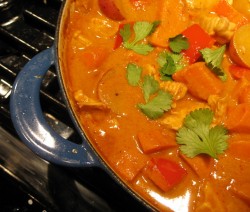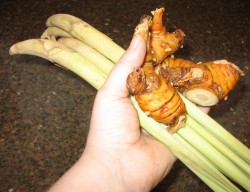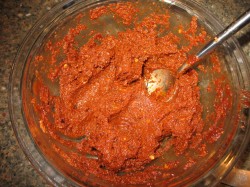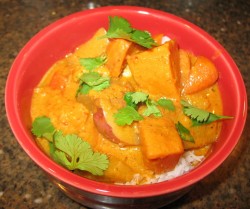Thai Red Curry: A Lesson In Flavor Balance
When Americans talk about Thai food, many of them get caught up by the heat of the chile peppers, which either incites the machismo response of “I can take mine hotter than you can take yours,” or causes fear and distress among those whose palates are not accustomed to the burning sensation chiles impart to a dish.
But Thai food is not just about heat.
It is about balance.
It is about balance between flavors, an aesthetic balance in color, texture and form, and a balanced, nutritional diet.
If one focuses on the heat of Thai dishes, one loses the ability to percieve the glorious complexity that the cuisine has to offer. One loses the sour kiss of lime juice and tamarind, and the salty, savory kick of fish sauce and shrimp paste. It is hard to appreciate the incredible sweetness of pineapple or the luxurious richness of coconut milk if one is weeping in pain from the chiles. The floral aroma of kaffir lime leaves and pandanus leaves, or the medicinal tang of fresh turmeric and galangal get lost if one overloads her first Thai efforts with way too many chiles for her diners to tolerate.
Thai food is a complex, multi-dimensional sensual experience. To distill it down to one flavor sensation-the heat of chiles-is to dumb it down, to strip it of the layers of cultural and history that make it so special.
It is a travesty, and American cooks should not perpetuate such in their kitchens.
Yesterday, I gave Morganna her first lesson in Thai cookery; I did as I tend to with most students, and started her on keang pet daeng–red curry.
The reason I always start with red curry is that it many Americans associate Thai food most with either pad thai or a coconut milk curries. Of the coconut milk curries, the easiest to make, and the most balanced in terms of flavors is red curry. Neither overly sweet nor sour, nor overly spicy with chiles, nor very salty or bitter, red curry has aspects of all of these flavors in perfect proportions to each other. The curry paste is a good one to learn the procedure of making pastes with, because it is reasonably straightforward, and the dish can be dressed up or down with whatever fish, meat or fowl the cook prefers and a nearly endless variety of vegetables.
I have made red curry with shrimp and pineapple, deep fried tofu puffs, mushrooms and a mixture of root vegetables, and pork with sweet potatoes, but my favorite version, and the one that has never failed to please people is the one I present here: red curry with chicken, pineapple, and root vegetables.
As much as I adore making and eating various sorts of red curry at home, it is my least favorite curry to order in a restaurant. For whatever reason, I have found that in American Thai restaurants, red curry is the dish most likely to be bland, boring and flavorless. Perhaps because it has the reputation of being the most tame of all Thai curries, most restaurants present very watered-down versions of it that timid American palates enjoy. Perhaps we are just spoiled by what homemade curry pastes taste like, but for whatever reason, Zak and I have not been able to order red curry in a restaurant and be satisfied by it for many years.
So, I always make it at home, and don’t worry over it.
(Before I describe how to go about making the curry paste, I know that I am going to be asked what kind of already prepared curry paste someone can use if they don’t have time to make my curry paste, so I will just say so now. If you must use a packaged curry paste, Mae Ploy–in the resealable plastic tubs–makes the best on the market. Their red curry, panang and massamun pastes are all good–however, please don’t bother with making green curry if you are not going to make the paste from scratch. It won’t taste right. Trust me. In a future post, I promise to explain why.)
Two ingredients that are necessary to making Thai curry pastes fresh are fresh (or frozen) galangal and lemongrass. Many Asian markets and some Whole Foods produce sections carry fresh galangal. If you cannot get it fresh, as it is presented in the photograph, you can get it frozen in chunks at many Asian markets. Just look in the frozen cases where vegetable matter is sold and you can find it. It looks just as knobby and gnarled frozen as it does fresh–it is unpeeled. Folks just hack it into chunks and stick it into bags and freeze it. It is also, in whichever state you buy it, hard as a knot of wood. If you are going to be making curry paste by hand, chopping it in a food processor, and then mashing it into a pulp with a mortar and pestle, then I suggest frozen galangal. The aroma and flavor are nearly identical to the fresh, but the hard texture has been broken down a bit by the freezing process, so it is easier to pound into a paste. Just let it thaw out first. (You can refreeze what you do not use for another time.)
Lemongrass should be much easier to find. Look for stalks that are still pliable all the way up if you can manage it, with outer leaves that are only slightly dry. When you bring them home, wrap them loosely in a paper bag and keep them in the produce drawer of the fridge and they will stay fresh for several weeks. To use them, you cut off the very bottom of the stalk, then peel off a couple of the outer layers of leaves, then use only the lower third of the rest of the stalk. The upper stalk bits are too tough and dry to use. If you are making your paste by hand, I recommend using a food processor to chop the tough stalks into bits first, then the mortar and pestle to pound them together with the other ingredients.
My advice is to make sure that you can get these two ingredients before you decide to make curry paste. Fresh or frozen–dried is really not a good option. Dried galangal is okay for tom kha gai–galangal and chicken soup–but it really doesn’t do much for a curry paste. Dry lemongrass is about as good as sawdust; it is completely lacking in the lemony floral fragrance that the fresh stalks have. If you cannot find these ingredients where you live, try this website for fresh Thai produce. I have ordered from them several times and have always gotten great products and service from them.
When it comes to making the curry paste itself, I use my Sumeet grinder, the virtues of which I have extolled so many times on this blog I fear to become redundant. However, I have to say that if one intends to make a lot of Indian, Thai and Mexican dishes as I do, all of which require a great deal of flavoring pastes, the Sumeet pays for itself within six months. Blenders do not do an adequate job, food processors and choppers can only go so far, and frankly, the mortar and pestle are so time consuming and tedious that it deters most American cooks from even attempting to make curry pastes from scratch. Believe me, I have made curry pastes from scratch by using a food processor to chop everything to small bits, a coffee grinder to grind the dried spices and a mortar and pestle to turn all of it into a paste, and it is a long, and physically demanding job.
So, do yourself a favor and get a Sumeet. The price has even come down since Zak got me mine seven years ago. (Yes, mine is that old. And it still runs beautifully. I am telling you, when they build small appliances in India, they make them to last!) (And no, Sumeet International does not give me money to endorse them.)
Once the curry paste is made, I always work to balance the flavor of the curry sauce itself before I add the meat ingredient. This is so I can be certain to get the perfect flavor before I can no longer taste the sauce. I taste at every step, from tasting the just made curry paste, to tasting it after I have fried it in the coconut cream, to adding the coconut milk and fish sauce, (can you say “umami?” I knew you could) to adding the sweetener.
The only flavoring step I leave to the very last is the adding of the souring agent–in this case–lime juice. There is a very simple reason for this. Lime juice, if you add it early in the cooking process, will boil away before the curry is finished cooking. In that case, you would have to add more anyway, so always leave the lime juice until the last.
I realize as I write this, that red curry sounds like the most complex dish in the world to make. That is not the case; Morganna even admitted to that as we worked together. She said, “It is not hard: there are just a lot of ingredients to keep track of.” It is just that there is so much advice for me to give to make the process simpler for a beginner, because I remember how hard it seemed when I started. But now that I have no fear of it, and have a good piece of equipment to help me, I can make curry pastes quite simply and easily.
So, without further ado, here is the recipe for my red curry paste and a curry made with it. I adapted from two recipes, over a series of years, and have changed it considerably. The original recipes which inspired my version come from Kasma Loha Unchit’s book, It Rains Fishes, which is sadly out of print, and Su-Mei Yu’s Cracking the Coconut.
Red Curry Chicken with Pineapple and Root Vegetables
Curry Paste Ingredients:
8 large dried red chile colorado/New Mexico chiles, soaked in warm water until softened
1/2 teaspoon white peppercorns
1/2 tablespoon coriander seeds
1 teaspoon. kosher salt or sea salt
8 large cloves garlic, peeled and chopped
2 black cardamom pods
1/4 teaspoon cardamom seeds
1/4 teaspoon ground nutmeg (or a chunk of whole nutmeg about 1/4″ cubed
1 stalk lemongrass, prepared as noted above, and sliced into thin slices
1″ cubed chunk fresh galangal root, peeled and cut into thin slices
10-15 fresh or frozen red Thai bird chiles (prik kee noo)
2″ square chunk red sweet bell pepper
1 tablespoon lime zest, finely grated
2 tablespoons cilantro stems (or 1 tablespoon cilantro roots)
1 1/2 teaspoons shrimp paste (Do not leave this out. I don’t care that it looks ugly and smells scary. If you don’t use it your curry won’t taste right.)
Method:
Remove stems to dried soaked chiles and squeeze out excess water. Remove stems from fresh chiles. If you have a grinder like a Sumeet, load up as many of the ingredients as will fit in the jar and process it until they are smooth. Scrape contents out into a bowl, and finish with the rest of the ingredients. Scrape them out into the bowl, and mix them thoroughly together. Do not leave out that shrimp paste!
If you are going to go for the food processor and mortar and pestle route, grind the hard dried spices like peppercorns and cardamom into rough, coarse bits. Mix this with the salt. Chop all the other ingredients in a food processor into as fine a paste as you can manage. It will not be very fine.
Using the salt/spice mixture as an abrasive, add a bit of it to the bowl of the mortar, along with a bit of the chopped up bits and take the pestle and start grinding away. Pound until a smooth paste forms. Dump this into a bowl, and repeat steps as needed.
Put on some music, get a groove going and get comfortable. You will be there for a while. (Do you see why I have a Sumeet?)
Ingredients for Curry:
About 2/3 of the batch of red curry paste–or to your taste (What you don’t use you can put in the fridge or freezer in a tightly sealed container for another day–or you can do what I am doing and make pad thai the next day and use the rest of the paste up. But, it does keep for about a week or two in the fridge, and forever in the freezer.)
1 can Mae Ploy coconut milk
1 can Chao Koh coconut milk
1 1/2 tablespoons (or to taste) raw sugar
Fish sauce to taste (I use Golden Boy brand)
1/2 fresh pineapple, cut into generous chunks along with whatever juice escapes from the pineapple
5 new potatoes, scrubbed and cut into quarters
12 baby carrots cut diagonally across the center axis
1 sweet potato, peeled and cut into crescent-shaped chunks
1 1/2 boneless skinless chicken breasts, trimmed and cut into 1″ chunks
lime juice to taste (I use the juice of 1 1/2-2 limes, depending on how juicy they are.)
handful cilantro leaves
Method:
Crack open the can of Mae Ploy coconut milk (Do not shake it up before opening it) and scrape out the thick coconut cream from the top. There will be lots of it–Mae Ploy is very creamy. (For a less rich curry, use two and a half cans of the Chao Koh.) Put the coconut cream in the bottom of a wide, heavy bottomed pan. (Enamelled cast iron rocks for cooking Thai curries.) Heat it up on high until the cream melts and begins to bubble. Add the curry paste, and cook, stirring, until you have a thick, dark orange-red, very fragrant paste. Turn down the heat and cook slowly, for about fifteen to twenty minutes. The longer you cook at this stage, the better your curry will be. Put on meditative music, pull up a stool, sit down and stir. You will thank me if later if you do this. Taste the mixture as soon as you mix them together and after they have cooked. Taste the difference? Good.
After about twenty minutes have passed, add the rest of the can of Mae Ploy, and the contents of the can of Chao Koh, which you may shake up before you open. Stir the coconut milk into the curry, and when it is mixed in all the way, taste it. It tastes flat, doesn’t it? Fear not.
Take up the fish sauce fearlessly. Shake in a good amount of it. (I think I use at least a third of a cup of it, but I don’t know, because I shake it in until it smells right.) When you think you have enough, stop, stir, and then taste. Not only should it taste a little salty, that flatness will have been dealt with. It suddenly tastes better! (Umami is at work again.) Add the pineapple, juice and sugar. Stir in well, and taste it again.
There should be a balance now between hot, savory, salty and sweet. Taste for it. Adjust as necessary. For heat, add more curry paste, by the half teaspoonful. For savory and salty, add fish sauce. For sweet, add sugar, by the pinch.(If salt is the only lack, add a pinch or two of kosher or sea salt instead of fish sauce, if you want. But really, you cannot add too much fish sauce.)
At this point, add the potatoes and carrots and cover pot, lower heat to a simmer and cook until the vegetables are halfway tender. Add the sweet potatoes at this time. Cover and cook again until the roots are almost done, then add chicken. (Doing it like this makes sure you do not overcook the chicken. It should just be barely done.)
Taste the sauce. Add as much lime juice as is needed to balance everything with a good shot of sour.
Sprinkle with cilantro leaves and serve in bowls over steamed jasmine rice.
Note: If you can get kaffir lime leaves, add 2 or 3 of them to the curry when you put the potatoes and carrots in. They will add an incomparable floral scent to the curry that is intoxicating.
There it is.
This was the first way that I got Zak to eat sweet potatoes. Now, he likes them just plain roasted or mashed, but the best way to eat them is still in red curry. Coconut milk and sweet potatoes just do lovely things for each other.
14 Comments
RSS feed for comments on this post.
Sorry, the comment form is closed at this time.
Powered by WordPress. Graphics by Zak Kramer.
Design update by Daniel Trout.
Entries and comments feeds.







This is totally rude, but, what can I say? I’m shameless when it comes to good food. Can you please invite me over the next time you make this? Puh-lease? Red curry is one of my all-time favorit meals ever.
Comment by Courtney — January 12, 2006 #
Nah, it isn’t rude.
Next time I make red curry, I will call you in advance, so you can come learn how to make it, and then eat some.
Is that a deal?
Comment by Barbara — January 12, 2006 #
That sounds like a delicious plan. Deal!
Comment by Courtney — January 12, 2006 #
Barbara – I missed out on the Smeet discussion. Went on the web to check this out and find 2 sizes – multigrind (smaller) and big Asia machine (obviously bigger). Which one do you have? Maureen
Comment by Maureen — January 12, 2006 #
I have the smaller Sumeet Multi-Grind. It is a solid piece of equipment, and I have never had trouble with it, and I have used it a lot for the past seven years since Zak got it for me.
I have to admit to having a lustful desire for the larger model so I can do more than just a handful of fresh masa at a time–I have the corn, I have the slaked lime to use to remove the skin, but my grinder can only do small bits at a time. Otherwise–I would have truly fresh tortillas and tamales very often at my house. 😉
Comment by Barbara — January 12, 2006 #
Never thought of using it for corn but then I live in San Diego and can go under the Coronado Bridge and buy masa freshly prepared for tamales. Tortillas come right off the grill still hot. It is nice to know the multi-grind would do that too if I ever should be crazy enough to move. I think the sumeet goes on my birthday wish list.
Thanks – Maureen
Comment by Maureen — January 12, 2006 #
Ah, yes–here in Athens, there is no fresh masa, unless I get the method to make it! I still do well enough with Maseca dried masa, but I really want to try making it fresh.
Good luck with the Sumeet. You will not be disappointed, not at all. It is a very, very useful device.
Let me know what you think of it if the birthday fairy brings it for you!
Comment by Barbara — January 12, 2006 #
wow- i decided to go and find all the ingredients over here in holland, and i did. the food came out great…very tasty…i was experimenting with indian food and now you got me hooked on some thai vibes…thank you…how much does a sumeer grinder cost?
Comment by neek — April 7, 2006 #
Hve you ever tried red curry with thai sweet basil , a subsitute for the cilantro(corriander) very flavourful.
my recipe is w/ pumpkin, sweet basil, 1 tsp shrimp paste, bamboo shoots (1 can drained) and pineapple is actually good with this too.
Comment by Jake — July 29, 2006 #
Neek–I am happy to hear that it turned out well!
A Sumeet is about 90.00 dollars or so these days, with shipping a bit more, I think. It is well worth it–mine has lasted about eight years of hard use now.
Jake–I do sometimes use Thai basil when it is available. In the summer, I grow it and use it a lot. But, in January, I am much more likely to get cilantro to use.
Pumpkin would probably taste kind of like sweet potato, I bet!
Comment by Barbara — July 31, 2006 #
Red Curry Paste- you list both cardomom pods and seeds
am i suppose to use both when making my paste?
Comment by Dean — August 16, 2006 #
Dean–Black cardamom pods are different than regular cardamom seeds. Black cardamom is from the plant, Amomum subulatum, and is available in most Indian grocery stores. For a full description of the plant, the spice, its name in various languages and photos of the seed pods, which can be used whole or ground, refer to this link to Gernot Katzer’s Spice Pages: http://www.uni-graz.at/~katzer/engl/Amom_sub.html
The cardamom seeds are from the more familiar green cardamom pods that we are used to seeing in the West. If you cannot find the black cardamom, leave it out of the curry paste, and use another 1/8th teaspoon of the regular cardamom seeds.
I hope that clarified the ingredients a bit more for you.
Comment by Barbara — August 16, 2006 #
Thank You – I made Red Thai Curry sauce but from commercially made paste – it was ok…lacked the umph that I love when I eat out….Going to make the paste over the weekend….will let you know how it comes out
Comment by Dean — August 18, 2006 #
Hello all
1st time visitor here. I have just begun exploring and love the obvious passion you have for the creations you present. Your recipes are thoughtful and well written. But you don’t need me to say that.
Cats never just go for a walk…they go for an adventure. I value that lesson in life and in dining.
I am trying your Thom ka ghai recipe. Fortunately I live in Washington, DC 6 blocks from the capitol and 10 minutes over the bridge into northern Virginia. The resources for Asian…really, the resources for the international community in general are outstanding.
I will visit again. Your blog has been added to my favorites 🙂
If you have the black cardamom seeds, try throwing a half dozen (seeds) in the brew basket for your next pot of coffee. A nice diversion.
Cheers!!
Comment by Jerry — November 20, 2007 #